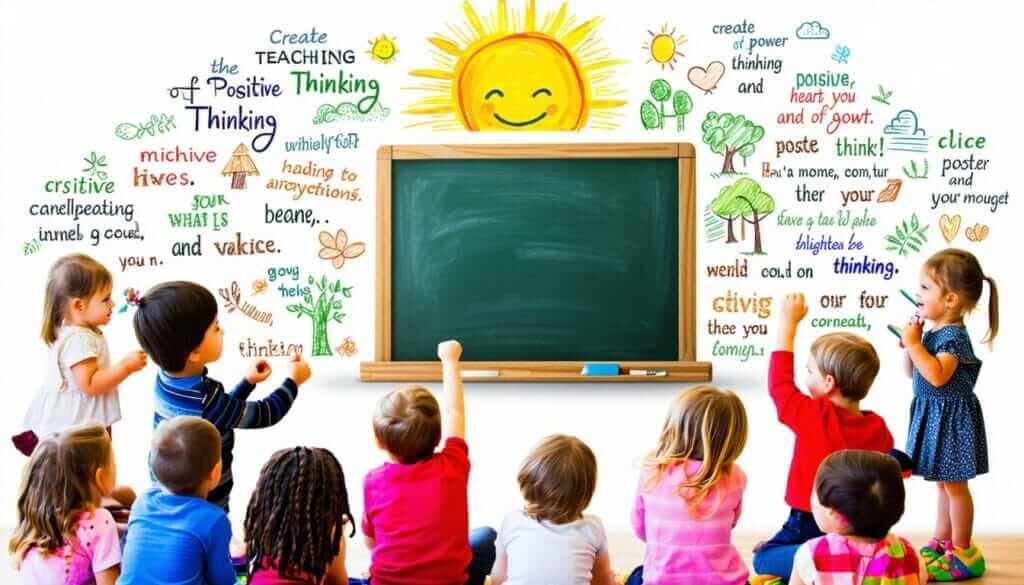The Power of Positive Thinking
Importance of Positive Guidance
Kicking off this positivity bandwagon starts with teaching kids how to think on the bright side. Positive guidance isn’t just a fancy way of saying, “Be nice.” It’s about building life skills like keeping cool under pressure and knowing when to hit pause before acting. This approach helps kids tackle bad habits in a more constructive way and makes them pros at decision-making while owning up to their actions. When you use these positivity tricks, you’re nudging your kid to mull over their choices and understand the ripple effect of their actions.
Here are some ace tactics for nailing positive guidance:
| Strategy | What It Means |
|---|---|
| Positive Language | Dish out instructions in a helpful way to guide their actions. |
| Offer Choices | Let kids pick their path sometimes, boosting their independence and decision-making chops. |
| Use Redirection | Swap out the bad vibes for good ones, steering actions in a better direction. |
| Timing | Share advice when they’re in the mood to listen for better outcomes. |
| Observation | Keep an eye on habits and tailor your guidance to each child’s needs. |
Having a positivity playbook can really dial down the disruptions. Plus, it’s key for keeping your kid’s self-worth intact while you steer their behavior.
Directing Behavior with Positivity
Pointing kids in a positive direction can change how they see the world, helping them face hurdles head-on and spot new chances. A good outlook boosts resilience, crafting a mindset where they trust their skills. Tossing in a little goal-setting or finding daily joys can pump up their optimism and fire up a “Yes I Can!” spirit (Big Life Journal).
Day in and day out, show them the ropes of self-affection and staying present. Dive into fun stuff like activities for positive thinking for kids or show them positive thinking techniques to nurture that sunny outlook. Even a high-five for little wins can boost their self-esteem and keep that shining outlook on point.
By leaning heavily on these smart guidance moves and cheering them on, you’re setting up your kid for a rock-solid mindset that leads to feeling good and growing strong. If you’re hungry for more ways to sprinkle these values into their world, check out tips for building a positive attitude in kids or teaching kids to bounce back through positive thinking.
Developing a Growth Mindset
Helping your child develop a growth mindset sets them up for success and happiness. By getting a grip on the difference between a growth mindset and a fixed one, you can point your kid toward a more resilient and upbeat attitude. Also, showing them how to shake off negative thoughts can really boost their self-confidence and attitude.
Understanding Growth vs. Fixed Mindset
A growth mindset means you believe that skills and smarts can get better with hard work and dedication. On the flip side, a fixed mindset is thinking that intelligence and abilities are stuck where they are. Research has your back here—kids with that growth mindset usually do better than those who think they’re stuck in a rut and bounce back from failures better (Positive Psychology).
| Mindset Type | Characteristics | Impact on Learning |
|---|---|---|
| Growth | Tackles challenges, keeps going despite setbacks | More resilient and successful |
| Fixed | Dodges challenges, gets rattled by feedback | Less motivated and underperformed |
Share stories about icons who stumbled a few times before nailing it, so your child sees stumbles as stepping stones, not roadblocks.
Reframing Negative Thoughts
Teach your child how to flip the script on negative thoughts to nurture a brighter mindset. When challenges stare them down, show them how to swap out the negativity for positive vibes. So, if they say, “I can’t do this,” help them switch it to, “I’ll give it my best shot.”
Flipping the negative to the positive boosts self-esteem and builds a tougher attitude.
Here’s a handy table to help spot some typical downer thoughts and turn them around:
| Negative Thought | Positive Reframe |
|---|---|
| I’m not good at this. | I’m learning and improving. |
| I always fail. | I learn from my mistakes. |
| This is too hard for me. | I’ll ask for help and try again. |
Try out strategies like a reward system for progress, which keeps the spotlight on effort and getting better (Positive Psychology). When you encourage your child to think positively, you lay down the groundwork for their learning and problem-solving skills.
Dive into more about teaching children positive thinking techniques and developing a growth mindset in kids, to help your child start soaking up positivity.
Nurturing Optimism in Kids
Helping your child see the brighter side can play a big part in their emotional growth and happiness. When kids learn to expect good things, they’re picking up a valuable life hack that is optimism.
Growing Hope and Bright Views
Hope and optimism pave the way for your child’s well-being. These traits bring a rosy perspective and can be tools for keeping their mental health in check. Teaching your kid to aim for the best can toughen them up for life’s bumps.
Here are some ways to cultivate hope:
- Show Optimism: Talk about when you’ve faced challenges and come out on top. Your attitude can shape how they see their own chances.
- Set Realistic Goals: Guide your child to create manageable goals. Hitting these targets can boost their belief in a promising future.
- Talk About ‘What Ifs’: Have chats about possible outcomes of different situations. Lend them a view of what’s possible rather than what’s not.
| Strategy | Description |
|---|---|
| Show Optimism | Use your experiences to illustrate a positive view. |
| Set Realistic Goals | Help kids make and strive for goals they can achieve. |
| Talk About ‘What Ifs’ | Discuss different scenarios, focusing on hope. |
Building Positive Hopes
Pushing positive expectations can lead to a happier, more adaptable child. Those who think optimistically see bad times as short-lived and manageable (Pursuit of Happiness). This angle helps tackle stress and shields against feeling down.
To instill positive hopes, try these methods:
- Celebrate Wins: Make a big deal out of victories, no matter the size. Recognizing successes builds faith and fosters a sunny outlook.
- Promote “Thank Yous”: Encourage your kid to be thankful. Grateful people typically stay happier and connect better with others.
- Teach Cheery Talk: Guide your child to swap negative thoughts for positive pep talks. This can support a can-do mindset and emotional strength.
| Method | Description |
|---|---|
| Celebrate Wins | Recognize achievements to boost confidence. |
| Promote “Thank Yous” | Encourage gratitude to bolster emotional health. |
| Teach Cheery Talk | Help develop positive self-talk habits. |
These strategies, when woven into your kid’s daily routine, can nurture an optimistic outlook and set them up as resilient, self-assured individuals. For more tricks on nurturing a bright mindset, visit our resources on teaching kids the magic of thinking positive and boosting emotional smarts with a positive twist.
Techniques for Fostering Positive Thinking
Helping your kiddo think positively doesn’t have to be tricky. With a little focus on being present, kind, and compassionate, they can start seeing the brighter side of life. Dive into these cool strategies you can use every day.
Teaching Mindfulness and Compassion
Mindfulness is about staying present and accepting your thoughts and feelings without being hard on yourself. Kids can get into mindfulness through easy activities like breathing exercises or something called Loving-Kindness Meditation, which is about sending good vibes to people you care about. This can help kids grow kinder, more compassionate, and happier.
Try these activities to bring a bit of mindfulness into their lives:
| Activity | What It’s About |
|---|---|
| Breathing Exercises | Help your child focus on slow, deep breaths to melt away stress and bring on the calm. |
| Nature Walks | A stroll in the great outdoors sharpens their senses and makes them pay attention to all the beauty around them. |
| Mindful Coloring | Dive into coloring to boost concentration. The focus can be soothing and help plant seeds of relaxation. |
Add these fun bits into daily life, and watch how your kid brightens up with awareness. They’ll start to handle emotions better and tackle ups and downs with a positive spin. More neat ideas can be found in this handy guide to teaching children mindfulness for a positive mindset.
Encouraging Acts of Kindness
Getting your kid to do nice things for others is a solid way to boost their mood and outlook on life. Acts of kindness don’t just make the world a better place—they help kids feel great about themselves. Start with a kindness challenge: have them jot down what they did, why, and how it felt.
Here are some simple kindness ideas:
| Kindness Activity | What To Do |
|---|---|
| Helping a Friend | Offer a hand with schoolwork or share a favorite toy. |
| Compliments | Motivate your child to say kind words to friends or family. |
| Community Service | Get involved in local clean-ups, showing them how to give back and the value of pitching in. |
Make a “yet crown” to encourage them to try new things while feeling proud. Decorated with unachieved goals, it reminds them they’re growing and learning. Want more fun stuff on kindness and resilience? Check out teaching children optimism and resilience.
Mixing mindfulness and kind acts into the daily grind helps kids build a mindset full of “Yes I Can!” These tricks set them up to grow into positive, resilient champs ready to tackle whatever comes their way.
Impact of Positive Thinking
Getting your child into the habit of positive thinking can really make a difference in how they handle tough situations and keep their spirits up. It’s like giving them a superpower to handle life’s bumps with a smile and some swagger.
Building Mental Toughness
Thinking positively is hugely beneficial when it comes to building mental toughness in kids. Neurobiologist Richard Davidson mentions that the brain works like a muscle—train it right, and it gets stronger. So, when kids engage in positive stuff, their brains become better at handling whatever life throws at them (Big Life Journal).
When kids learn to see setbacks as challenges instead of roadblocks, they become more adept at bouncing back. Check out how positive mindsets work their magic in making kids more resilient:
- Adaptability: They can slide into new situations without a fuss.
- Problem-Solving: They get better at cracking life’s puzzles.
- Coping Strategies: They develop nifty ways to keep stress in check.
Getting them involved in goal-setting or just appreciating little wonders each day can beef up their resilience. For instance, jotting down happy moments can boost their mood and sprinkle some sunshine on their day (Big Life Journal).
Boosting Emotional Health
Fostering a sunny mindset doesn’t just help with tackling challenges—it helps kids feel better all around. Kids who practice positive thinking tend to have higher self-esteem and a happier outlook. Fun fact: doing good deeds, like volunteering, can make them feel awesome and improve their mood (Big Life Journal).
Things like Loving-Kindness Meditation can teach them kindness and compassion, making them better buddies and giving life more meaning.
Helping your kid feel better about themselves and encouraging them to socialize positively can have lasting impacts. Get them into positive thinking activities for children or creating a positive space at home to support them emotionally. For more cool ideas, check out how you can teach children optimism and resilience and get insights on promoting positive self-talk in children.
By coaching your child in the art of positive thinking, you’re giving them a “Yes I Can!” mindset, ready to roll with whatever comes next.
Implementing Positive Reinforcement
Bringing positive reinforcement into your parenting tool kit is like adding a sprinkle of magic dust to your child’s growth. It’s about using rewards and encouragement to boost their confidence and self-esteem. Let’s dive into how you can make it work for your little superstar.
Utilizing Rewards and Encouragement
Rewards and encouragement? That’s the bread and butter of positive reinforcement—a concept first broached by psychologist Edward Thorndike and made famous by B.F. Skinner. Research has our back, showing that when you reward desired behaviors, your kiddo is more likely to repeat them. Let’s break it down:
| Strategy | Description |
|---|---|
| Verbal Praise | Be specific with your compliments, like saying, “You really nailed that project!” It shows you’ve noticed their hard work. |
| Certificates | Design some cool awards for even small victories, giving your child a sense of achievement. |
| Small Treats | Occasionally, a little treat or extra playtime acts as a sweet “good job!” |
| Positive Notes | Tuck encouraging notes in their backpack or lunchbox for happy surprises during the day. |
It’s less about performance and more about recognizing effort. Studies say parents who cheer for their child’s hard work see an uptick in academic success.
Shouting out not just actions but the sweat and tears behind them sets up a fantastic learning vibe and nudges your child towards greatness.
Creating a Supportive Learning Environment
Building a supportive learning sanctuary where kids feel safe to share, stumble, and get back up is key to growing positive thinking. Here’s how you can sprinkle some magic in your home:
| Strategy | Description |
|---|---|
| Open Dialogue | Keep the convo open and regular. Talk about feelings, dreams, or even what’s for dinner—stay engaged! |
| Celebrate Achievements | Whether they’ve conquered math homework or finally mastered their shoelaces, celebrate those wins! |
| Encouragement of Independence | Let ’em spread their wings with age-appropriate decisions to sharpen those problem-solving skills. |
| Positive Environment | Fill their space with good vibes—artwork, books, or posters—to inspire positivity. |
These approaches boost your child’s emotional wellness. Around the globe, from China to Abu Dhabi, schools are using positive reinforcement to boost learning. Teachers’ praise strengthens kids’ confidence and makes them shine bright (Educater).
Don’t stop here! There’s a whole world of wisdom on fostering a positive mindset in children. By weaving positive reinforcement into everyday life, you’re not just raising a kid who believes in themselves and celebrates life with a smile.




